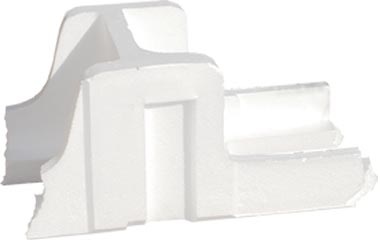Expanded Polystyrene (EPS) Recycling & Disposal

EPS (StyrofoamTM) cannot be recycled in your home recycling cart. EPS can be disposed in your garbage can at home.
You can recycle EPS at special events and some collection locations, or through paid doorstep service; however, it is not a valuable material for recycling. If you have only a small quantity, we encourage you to dispose of it in your garbage.
EPS Recycling Events
We will be holding recycling events that accept block EPS occasionally. Events will not be on a regular schedule, but balanced with events for other materials with greater environmental benefits.
EPS collected at recycling events now have a user fee, so those who use the service pay for it. This aligns with our user fees for other expensive and difficult to recycle materials, such as mattresses and CFC appliances. Learn about the challenges and limitations of EPS recycling below.
Sign up for email reminders about upcoming recycling events, or check our events calendar.
Other EPS Disposal Options
EPS is not accepted in your recycling cart at home. EPS can be disposed as garbage in your regular trash can at home, or large quantities can be thrown away at the Houghton Transfer Station in Kirkland for a fee.
Free Drop-off Recycling in the Seattle Area
Free drop-off recycling is available in Kent or at the Shoreline Transfer Station.
If you only have a small quantity of material, we encourage you to throw it away rather than making a special trip to a distant location, or combine with another trip to the same area. That way you can minimize the environmental impacts of transporting the EPS, which could be greater than the environmental benefit of recycling a small amount of material.
Paid Doorstep Collection
Ridwell provides doorstep collection of EPS as an add-on to their recycling subscription service. Find other private recycling services at King County's What Do I Do With directory.
The Challenges of EPS Recycling
EPS is a challenging material to recycle. It is not a valuable material for recycling, so the cost to collect and process it is often more than the value of the recycled material. It also requires delicate handling to prevent pollution.
That's why there are so few recycling options available. Only one company in the Seattle area recycles EPS. Their capacity sets a limit on how much foam the region can recycle.
EPS is not worth a lot to recycle
EPS (StyrofoamTM) is made of mostly air, and only contains a small amount of plastic. It is melted down to get rid of the air before being sold to manufacturers.
A cubic yard of EPS (3 feet by 3 feet by 3 feet) yields less than 10 pounds of plastic. For comparison, a cubic yard of mixed plastic bottles and containers makes about 30-50 pounds of plastic.
For something to be recycled, the material must be used to make a new product. Manufacturers can choose between using new and recycled material to make their products. Plastic is made out of oil; when oil is cheap, it costs less to make brand-new plastic than to use recycled plastic. Low oil prices mean fewer manufacturers want to buy recycled plastic material.
EPS Contaminates Recycling
EPS can't be recycled in the curbside cart because it breaks into tiny pieces. Those can't be cleaned out from other recycling, so it makes other materials harder to recycle and worth less.